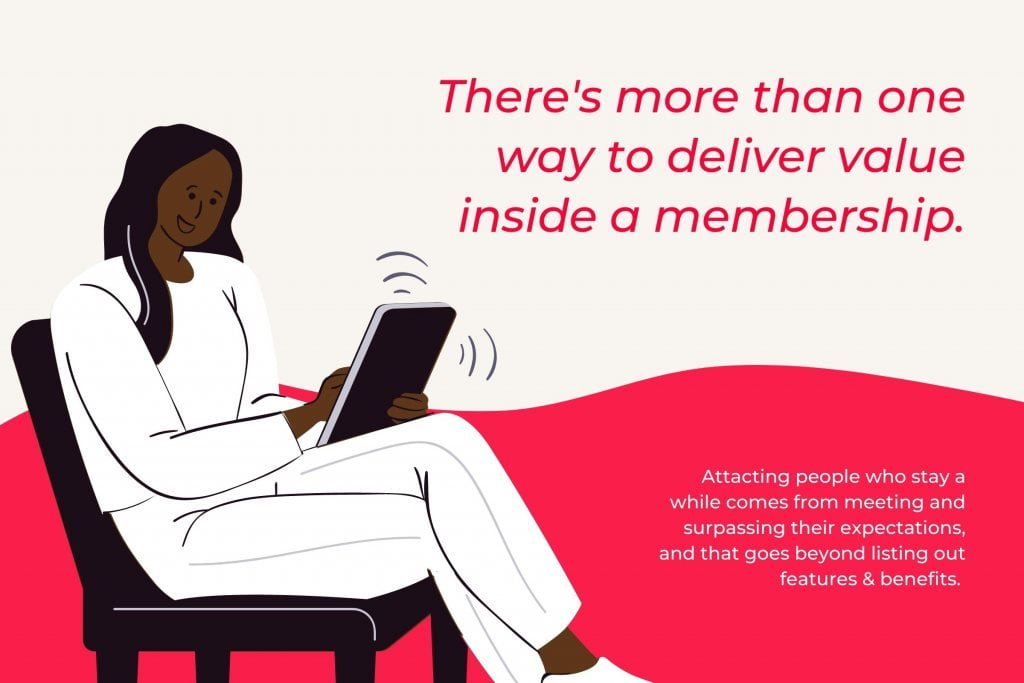Successful Membership Businesses Deliver What You Do Best
Choosing the right model for your zone of genius
What I love about membership programs the most is that there are a few different models within this business model. Deciding on the primary function of the model will help you set it up properly for lasting success.
There are some important attributes to consider. Firstly, know the core benefit your members will receive from joining. What will make their life better? Here are three main types of membership business models that coaches and consultants launch that can thrive:
- Education
- Coaching
- Community
Many memberships will have a combination of all of these but there's still ONE main one that has to remain consistent for the program to stay relevant. If you're thinking of starting this type of offer, make sure you have a plan to over-deliver on one of these.
Education - Grow your membership site through increasing skills & capabilities
A membership site can simply be another way to charge monthly for dripped out content and offering ongoing support. For businesses that drip out new, relevant content every month to help their members do ongoing tasks like lesson plans or social media, a monthly recurring membership program is a great way to deliver important content to them consistently.
This attracts people to the highly valuable content at a price-point or commitment level that they can get their head around, reducing a barrier to giving it a try.
With these kinds of programs, there is often less emphasis on the coaching or community which means that the leaders of the group may not have to be as ever-present to make it relevant. While it's always a good idea to have a place to ask questions, group admins can be hired to manage it giving freedom to the business owner.
Which is so often a desired outcome for business owners - programs that can run on their own.
Having an easy-to-access and navigate content system is critical to a smooth onboarding experience. And setting it up from the start with a membership site platform like my fav, New Zenler, will make everything smoother.
Coaching - Provides access to in-time mentorship
Coaching communities might just be my favourite types of membership programs. They usually offer access to a leader or mentor with a strong skill set for a lot less than private coaching because it's a group setting. If the group is small enough, you should get your questions answered. So group size does have an influence on price-point.
Many coaching and access-focused memberships are run as alternatives to group coaching programs. The members will also get connected to other group members so the ones that are most successful have members with similar goals.
Case Study - Savvy Social School
One of the people I helped shift from primarily an education & community model to a coaching model is Andréa Jones of the Savvy Social School. Andréa's social media agency was growing and so was her audience. She created a group for people who wanted to do their own social and needed some guidance.
The group got going but it didn't grow to the level she envisioned...initially. After working together she made two key shifts that helped her double the members in her program and increase member retention.
The first was adding bi-monthly coaching calls to the offer. Her members wanted help with specific challenges and timely opportunities. This was not something that previously created training would help with. Because social media is very fluid and always changing, immediate access was key.
Secondly, we figured out that the people who needed her support the MOST - and would probably stick around a long time for it - were other social media managers who needed a place to troubleshoot and ask questions.
By getting more clear on her ideal members and focusing on serving them, she's created a membership community that's gone from surviving to thriving.

I worked with Lisa to revamp my brand messaging and she gave me tons of insight that led to an important shift in my business.
Within 6 months after working together, I was able to double the members in my program and increase my member retention.
Andrea Jones, Savvy Social School
Community - A space for like-minded people with common goals
The most common membership programs we hear about are communities. Their primary goal is to connect people with common interests which can be for support, knowledge, business opportunities etc.
Even though they are the most common, they are the trickiest. The benefits of joining a community that's all about the community might be different for each member. Some may be quite active - gathering info, helping others, sharing wisdom, meeting people - but others may not be as involved.
Solid and lasting communities often have well-liked leaders and some way of getting value from them that they couldn't access otherwise, or they have such a strong common interest with the others, they wouldn't want to miss being a part of it.
The problem with membership programs that are focused on community only is that you're competing with free. Because there are so many free interest groups out there, churn for paid communities is high. The value of the connections and experiences must be much higher than they could get for free elsewhere.

Irresistible outcomes that make members want to stay
You're growing a membership program to serve people in the best way possible, right?
So you'll want to attract people who stay a while, especially if there is no minimum time commitment. And that ultimately comes down to meeting and surpassing their expectations.
In all types of groups, the return on their investment (ROI) must be high enough for them to stay. Members will eventually leave and that's normal. This is called a churn rate.
You'll want to make sure the rate of leaving (churn rate) is low enough that the program is still profitable to run.
This is especially important to consider when advertising is driving interest and sales. The cost per acquisition (CPA) must not exceed the lifetime value (LTV) of the client.
If you're thinking of starting a membership program or growing your existing one, you'll want to get clear on the ONE CORE THING members must receive in order to find it valuable and stick it out.
That's the transformation you have to provide with your program features in order to deliver on what you promised.
But there are also some less obvious takeaways they might not have expected but are thrilled to receive.
These are the reasons why they'll stay long after they've achieved the results they originally wanted.
Some of these include:
- Validation & support (it just feels good to be heard)
- Problem-solving (saves time figuring out what to do next)
- ROI (leads to a revenue opportunity greater than the cost of the program)
Even just one course correction could save them a lot of headaches or give them an idea that makes a big impact for them. They don't need to participate in everything to have their membership ROI solidified.
Common pitfalls found in membership programs (a.k.a. why they don't work)

(I realize I'm truly dating myself here with this Atari?!?! reference of my first real video game romance - yes, it was Pitfall!)
The problems associated with running a membership program are very similar to any other business model. Except in some cases where the price point is so low and there's no minimum time commitment, the problems can be even bigger.
It's really hard to sell any type of service or package with the following conditions:
- Audience is too broad. In the world of business to business I see this all the time. They try to grow communities based on the network of the business owner and invite everyone to it. In order to serve everyone, they keep it open and then it begins to stall because there's not enough commonality amongst the members and not enough of them get their needs met.
- Focus is not specific enough. Related to the above, if the focus or topics aren't specific people won't know why they should join and other support options will be considered. A strong membership program should be set-up as the BEST place for that person to get their issue addressed so there's no real competition. Niche hard.
- Does not solve a complex problem. If a membership program is focused on solving a simple problem that gets solved immediately, then members may not find a need to stay very long. That's when churn becomes a big issue. More and more people will have to be found to sell to and that brings the profitability right down.
- Relies too much on community. I've already mentioned that relying on the community as the sole benefit and the people in it to do the work in making the group great, is risky. Strong leadership is very important and will be the differentiator in leading the clients' growth for the long-term.
So delivering just enough content (not too much) so you can truly solve members problems is the surest way to create raving fans. And that's how to build a strong brand!
However, sometimes it can be challenging to identify where you are falling short, or how to fix it on your own. In my podcast episode below, I share my thoughts on getting an outside perspective and how it can help your business.
